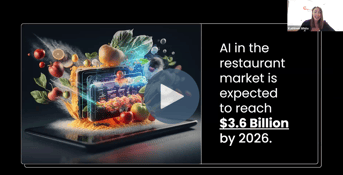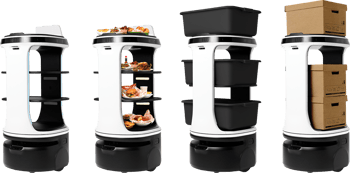While most of us don’t love sitting down to the dinner table and having to immediately whip out our phone, it’s now an inevitable part of many restaurant experiences. The pandemic ignited a demand for increased contactless interaction. And so began the QR menu takeover, emerging in numerous restaurants not just as a short-term fad, but as what many industry experts see as a permanent replacement for physical menus.
In August, CNBC reported that link management platform Bitly saw a 750% increase in QR downloads from the previous 18 months. There are plenty of reasons why the trend is continuing to unfold, as well as ways you can use the technology to your restaurant’s advantage.
The benefits of using QR codes
Two years into fighting this pandemic, we know now that the primary benefit of the QR code menu isn’t its ability to help stop the spread of COVID-19. The risk of infection from a paper menu is incredibly low. Instead, the benefits lay in the flexibility these digital menus provide to the operator.
QR codes allow operators to adjust menus in real-time. This means a strained staff no longer needs to waste time communicating to every customer when an item gets 86’d. It means prices can be easily adapted to inflation. Likewise, if a dish isn’t selling well, operators can test out a price drop. And it means every time the pesky supply chain decides not to cooperate, menu items and descriptions can pivot, without having to waste money on extra printing.
Some menu management platforms, like Menuflow, MenuLabs, and Waiterio, allow guests to place their entire order through a digital menu, sending tickets straight to the kitchen and enabling restaurants to operate with fewer servers. There are often opportunities to capture guest data, too.
But that doesn’t mean there aren’t challenges, and a poorly executed QR code menu can quickly backfire. In an industry where hospitality is at the core, QR codes inherently take away from the personal care and attention that defines “good” service. Add menus with painstakingly slow loading times, counterintuitive designs, and text that requires a magnifying glass or a knack for steadfast zooming, and you quickly turn hungry customers into disgruntled ones. In worst case scenarios, this leads to a loss of business, defeating any potential benefits.
The key here isn’t to create something unforgettable. Rather, you want a QR code experience so seamless that, when your customer leaves the restaurant, the digital menu doesn’t make it into memories of the meal. How? We break down ways to optimize your QR code menu for a better overall experience – for both the operator, and your customers.
Make PDF menus a last resort
Uploading a PDF document to a QR code generator is often the quickest and easiest way to digitize your menu. But it’s clunky, and far from the best experience for your customers.
“It works. It’s a solution. But in terms of the guest experience, it’s pretty cold,” says Steve Wright, founder and CEO of Scanour.menu. “A lot of PDF menus out there haven’t been formatted for mobile, so you’re trying to look at the menu, and you have to pan around, and it doesn’t resize. It’s just not a good experience.”
To optimize for mobile, you want to essentially create a mini website for your menu that utilizes responsive HTML. This could mean you simply link your QR code to a menu page that already exists on your restaurant’s website. Or, you take it to the next level by creating a fully interactive mobile menu.
“When you link to your website, that website should be mobile responsive, so it’s a little better because it doesn’t require the pinching and zooming, but the downside, especially for restaurants with massive menus like the Cheesecake Factory, is now you have to scroll endlessly to see the entire menu. The stuff that’s towards the bottom doesn’t sell,” says Colin Laberge, co-founder of MenuLabs. “With an interactive mobile menu, now you can navigate by category, so guests can jump to the drink menu, or categories on the food menu, and it solves the challenges of the scrolling.”
If you need something quick, PDFs work. But make sure your menu is formatted in one, easy-to-follow document. No one wants to have to click in and out of a separate PDF for every section of your menu. And try to keep your file size under five megabytes.
Consider a menu management platform
To create an interactive menu, the easiest option is to work with a menu management platform. This can run you anywhere from $25 to $50 for a monthly subscription. But the platforms make it effortless to custom design your menu and make changes on the fly.
Many platforms also allow you to build search queries into the design. This enables customers to not only sort the menu by “appetizer” vs. “dessert”, but also search by dietary preference, and pull up a list of, say, all vegetarian items, or all menu items that don’t contain peanuts.
Most menu management platforms have additional features you can add on, too, like table-side ordering and payment processing. This enables guests to use the same QR code to place an order, and/or pay the check, without flagging down a server. If you run a fast-casual spot, you may benefit from both, but even fine-dining spots can benefit from contactless payment.
Cut down on loading times
Another simple reason to avoid PDFs is that they typically load far slower than mobile-optimized menus. This is particularly true if you’re using the same high-resolution menu you’d otherwise send to the printer to make paper copies. Again, if you’re going with a PDF, make sure to aim for a file size of no more than five kilobytes, which may mean opting for a text-only menu.
“One of the biggest things with load times is images and media. If your menu has high resolution images of your dishes that aren’t properly compressed, the images can take seconds to load in themselves,” says LaBerge. “A good rule of thumb is under 100 kilobytes per image.”
If opting to use a menu management platform, be sure to ask if the software automatically optimizes all media that gets uploaded.
Design with your brand in mind, but be mindful of QR colors
QR codes don’t have to be a simple black-and-white pattern. You can change the colors, and even the shape, to match your brand. Some menu management platforms can help you incorporate your logo into the actual code, too. But you need to be mindful when playing around with design.
“You want good contrast between the two colors,” says LaBerge. “You don’t want a red code on a pink background, for example, because your phone’s essentially reading a barcode, and so that contrast is essential.”
Likewise, you want to print your QR code on easy-to-scan material, in a place that’s accessible to your customers. A QR code that’s not easily scannable is rendered useless. “If you choose to display your QR codes on an unusual surface, a salt shaker for example, your customers might love the idea, but they’ll be frustrated when they won’t be able to scan the code correctly,” notes Micha Maalouf, mobile payment app Sunday’s head of brand and communications for the North America region. “If you stick your codes behind a glass that’s too shiny, the reflections may also complicate the scanning process.”
Test, test, and test before putting into action
You wouldn’t feed customers a new menu item without trying it yourself, right? You shouldn’t send your QR code out into the real world without testing it yourself either. Before you even get to the step of printing the QR code, use your phone to scan a copy of it on your computer and make sure it redirects to the right menu page. Then go ahead and print a few copies, and test them out in multiple locations throughout your restaurant, under all the foreseeable lighting conditions. If your code works during the daytime, but fails to work under your candlelit tables at night, you need to make some adjustments.
Also take note if your restaurant has any areas with spotty cell service. If so, include a guest WiFi name and password on the print out with your QR code. “If you don’t get good Internet and your guests don’t have access to WiFi, avoid images or videos on your menu and keep the menu text-based,” says LaBerge.
It’s also a good idea to have a backup. You don’t need to print dozens of menus. But having a few paper copies – even if they’re marked up with menu changes – is smart in case something goes wrong, or you simply have a customer ask for a paper copy.
Make your QR code easy to find, and include calls-to-action
QR codes are designed to speed up processes like ordering, and potentially payment. But if your QR code isn’t easy to find, all you’re left with is confused and irritated customers.
You want to make your QR code as accessible as possible. The obvious place to start is to print it on a table tent. Or you can put a sticker on the corner of each table. (Note: invest in waterproof sticker material, if taking this route).
But maybe that doesn’t work for the aesthetics of your restaurants – and that’s okay. You have other options.
“It’s one of the most common questions I get asked. ‘How can I tastefully display the QR codes to guests so it’s not this ugly sticker?’,” says LaBerge. “But we’ve seen a ton of creative ways restaurants are using QR codes – from putting flags with the QR code into a floral arrangement on the table to getting it laser-engrained in metal, so you essentially have a table plaque.”
Another option is to print your QR menu on material that actually looks like a menu. While it functions like any other menu, it’s one you can update behind the scenes whenever you want.
“Brand it on a nice material – material makes all the difference for making it feel high-end,” says Laberge, who recommends Plike paper. “Plike almost feels rubbery, and you can get different weights to it so it feels thick, and different colors, too.”
It’s helpful to create signage customers can see right when they walk in, too, whether it’s on a sandwich board placed outside or a poster hanging in the window or near the host stand. This way customers know to expect a QR code menu before they even sit down. And if there’s any wait time before their seating, they can take a peek at the menu in advance.
Remember: QR codes are generally a supplement, not replacement, for person-to-person service
Sure, some fast-casual restaurants can get away with relying on QR code menus for much of the ordering process, especially with menu management platforms. But generally, the best dine-in experiences aren’t devoid of actual face-to-face interactions. Servers remain important for answering any questions about the menu and to simply provide customers with a comfortable, hospitable experience. Digital menus can alleviate pressure off your waitstaff – like getting to the table within minutes to drop off menus. But there’s certainly no replacement for friendly, quality, human service.





